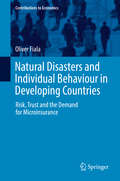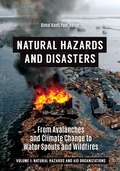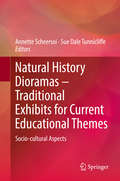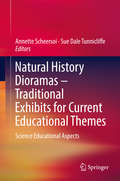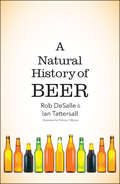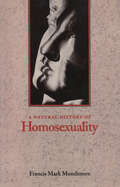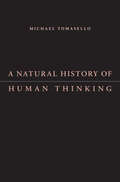- Table View
- List View
'Natural’ Disasters and Everyday Lives: Floods, Climate Justice and Marginalisation in India (Diverse Perspectives on Creating a Fairer Society)
by Suddhabrata Deb RoyDisasters have a widescale impact with drastic consequences on human lives, especially those who are marginalised by the wider society. Proposing a fresh approach towards analysing the politics of disasters, climate change and climate justice, 'Natural’ Disasters and Everyday Lives explores the relationship between citizens, the State and the society in the context of the Global South’s highly underdeveloped areas. Drawing on both theoretical frameworks and lived experience, this is the first book to document the lives of people affected by floods in the Barak Valley, a flood prone area in Southern Assam, which is also one of the most underdeveloped regions of South Asia. Narrating the fear and perils of living in an underdeveloped area in India during natural disasters, Suddhabrata Deb Roy draws from interviews conducted in Silchar, the largest and most developed urban settlement in the Barak Valley, during the floods of 2022 – the worst flood in the region in over 100 years – and during 2024 to expose the processes through which the people of the region suffer from developmental negligence and socio-political apathy. Examining the intersections of natural disasters and marginality, the author relates Marx’s ideas on humanism, nature, alienation and economic development to ideas around climate justice, marginalisation and urbanisation, taking into context the contradictions posed by factors such as class, caste, gender and race in highly underdeveloped regions in India. Recognising that these issues are addressed quite differently in the Global North, Deb Roy connects flooding in northeastern India to the context of the broader politics surrounding climate change and climate justice in the Global South, making this book important and powerful reading for countering today’s climate emergency.
Natural Disasters and Individual Behaviour in Developing Countries: Risk, Trust and the Demand for Microinsurance (Contributions to Economics)
by Oliver FialaThis study investigates the complex link between natural disasters, individual behaviour – in the form of an individual’s risk-taking propensity and level of trust – and the demand for microinsurance. Developing countries are particularly vulnerable to the impacts of natural hazards and climate change as they affect their development processes and set back poverty reduction efforts. Using a unique data set for rural Cambodia based on a survey, experimental games and a discrete choice experiment, the study highlights the importance of perceptions, expectations and psychological factors in decision-making processes with substantial consequences for long-term economic perspectives and poverty alleviation.
Natural Enemies: People-Wildlife Conflicts in Anthropological Perspective (European Association of Social Anthropologists)
by John KnightWild animals raid crops, attack livestock, and sometimes threaten people. Conflicts with wildlife are widespread, assume a variety of forms, and elicit a range of human responses. Wildlife pests are frequently demonized and resisted by local communities while routinely 'controlled' by state authorities. However, to the great concern of conservationists, the history of many people-wildlife conflicts lies in human encroachment into wildlife territory.In Natural Enemies the authors place the analytical focus on the human dimension of these conflicts - an area often neglected by specialists in applied ecology and wildlife management - and on their social and political contexts. Case studies of specific conflicts are drawn from Africa, Asia, Europe and America, and feature an assortment of wild animals, including chimpanzees, elephants, wild pigs, foxes, bears, wolves, pigeons and ducks.These anthropologists challenge the narrow utilitarian view of wildlife pestilence by revealing the cultural character of many of our 'natural enemies'. Their reports from the 'front-line' expose one fact - human conflict with wildlife is often an expression of conflict between people.
Natural Enemies: People-Wildlife Conflicts in Anthropological Perspective (European Association of Social Anthropologists)
by John KnightWild animals raid crops, attack livestock, and sometimes threaten people. Conflicts with wildlife are widespread, assume a variety of forms, and elicit a range of human responses. Wildlife pests are frequently demonized and resisted by local communities while routinely 'controlled' by state authorities. However, to the great concern of conservationists, the history of many people-wildlife conflicts lies in human encroachment into wildlife territory.In Natural Enemies the authors place the analytical focus on the human dimension of these conflicts - an area often neglected by specialists in applied ecology and wildlife management - and on their social and political contexts. Case studies of specific conflicts are drawn from Africa, Asia, Europe and America, and feature an assortment of wild animals, including chimpanzees, elephants, wild pigs, foxes, bears, wolves, pigeons and ducks.These anthropologists challenge the narrow utilitarian view of wildlife pestilence by revealing the cultural character of many of our 'natural enemies'. Their reports from the 'front-line' expose one fact - human conflict with wildlife is often an expression of conflict between people.
A Natural Experiment on Electoral Law Reform: Evaluating the Long Run Consequences of 1990s Electoral Reform in Italy and Japan (Studies in Public Choice #24)
by Daniela Giannetti and Bernard GrofmanIn the early 1990s, major electoral reforms took place in both Italy and Japan; each replaced a form of “proportional representation” (in which voters cast a ballot for a party list) with a “mixed member” system (in which voters cast ballots for individual candidates and party lists). The reforms were enacted by political elites in the context of divisions within the dominant party, changing patterns of party support, and party splits, in efforts to retain power while responding to charges of corruption, clientelism, and lack of accountability. The experiences of both countries provide a laboratory in which to investigate the effects and implications of the reforms, and, more broadly to analyze voter behavior in the context of institutional change. The introduction provides an overview of post-WWII politics and electoral reform in Italy and Japan. In each of the next four chapters, specialists in Italian and Japanese electoral politics are teamed up to review data both before and after the reforms. Within this comparative framework, the authors explore such topics as changes in party competition, candidate selection mechanisms, and intra-party politics. The concluding chapter considers the longer-term consequences—both anticipated and unanticipated—of the reforms; despite superficially similar conditions, the effects in the two countries were dramatically different: in Japan, the new system has taken hold, with minor modifications, while in Italy, there was a reversion to a proportional representation system. As the essays in this volume demonstrate, to understand why similar reforms had such different effects in the two countries we must examine how electoral systems are embedded in broader institutional and social arrangements, and at the complex interplay of political geography, political history, and the rational calculations of political actors.
Natural Hazard Mitigation
by Alessandra Jerolleman John J. KieferOne of the four core phases of emergency management, hazard mitigation is essential for reducing disaster effects on human populations and making communities more resilient to the impacts of hazards. Presenting an up-to-date look at the changing nature of disasters, Natural Hazard Mitigation offers practical guidance on the implementation and selec
Natural Hazards: Earth's Processes as Hazards, Disasters, and Catastrophes
by Edward A. Keller Duane E. DeVecchioThe new revised fifth edition of Natural Hazards remains the go-to introductory-level survey intended for university and college courses that are concerned with earth processes that have direct, and often sudden and violent, impacts on human society. The text integrates principles of geology, hydrology, meteorology, climatology, oceanography, soil science, ecology, and solar system astronomy. The textbook explains the earth processes that drive hazardous events in an understandable way, illustrate how these processes interact with our civilization, and describe how we can better adjust to their effects. Written by leading scholars in the area, the new edition of this book takes advantage of the greatly expanding amount of information regarding natural hazards, disasters, and catastrophes. The text is designed for learning with each chapter broken into small consumable chunks of content for students. Each chapter opens with a list of learning objectives and ends with revision as well as with high-level critical thinking questions. Concepts in Review section provides an innovative end of chapter section that breaks down the chapter content by section: reviewing the learning objectives, summary points, important visuals, and key terms. New case studies of hazardous events have been integrated into the text, and students are invited to actively apply their understanding of the five fundamental concepts that serve as a conceptual framework for the text. Figures, illustrations, and photos have been updated throughout. The book is designed for a course in natural hazards for non-science majors, and a primary goal of the text is to assist instructors in guiding students who may have little background in science to understand physical earth processes as natural hazards and their consequences to society.
Natural Hazards: Earthquakes, Volcanoes, and Landslides
by Ramesh Singh Darius BartlettOver the years, the interactions between land, ocean, biosphere and atmosphere have increased, mainly due to population growth and anthropogenic activities, which have impacted the climate and weather conditions at local, regional and global scales. Thus, natural hazards related to climate changes have significantly impacted human life and health on different spatio-temporal scales and with socioeconomic bearings. To monitor and analyze natural hazards, satellite data have been widely used in recent years by many developed and developing countries. In an effort to better understand and characterize the various underlying processes influencing natural hazards, and to carry out related impact assessments, Natural Hazards: Earthquakes, Volcanoes, and Landslides, presents a synthesis of what leading scientists and other professionals know about the impacts and the challenges when coping with climate change. Combining reviews of theories and methods with analysis of case studies, the book gives readers research information and analyses on satellite geophysical data, radar imaging and integrated approaches. It focuses also on dust storms, coastal subsidence and remote sensing mapping. Some case studies explore the roles of remote sensing related to landslides and volcanoes. Overall, improved understanding of the processes leading to these hazardous events will help scientists predict their occurrence. Features Provides information on the physics and physical processes of natural hazards, their monitoring and the mapping of damages associated with these hazards Explains how natural hazards are strongly associated with coupling between land–ocean–atmosphere Includes a comprehensive overview of the role of remote sensing in natural hazards worldwide Examines risk assessment in urban areas through numerical modelling and geoinformation technologies Demonstrates how data analysis can be used to aid in prediction and management of natural hazards
Natural Hazards: Earthquakes, Volcanoes, and Landslides
by Ramesh Singh Darius BartlettOver the years, the interactions between land, ocean, biosphere and atmosphere have increased, mainly due to population growth and anthropogenic activities, which have impacted the climate and weather conditions at local, regional and global scales. Thus, natural hazards related to climate changes have significantly impacted human life and health on different spatio-temporal scales and with socioeconomic bearings. To monitor and analyze natural hazards, satellite data have been widely used in recent years by many developed and developing countries. In an effort to better understand and characterize the various underlying processes influencing natural hazards, and to carry out related impact assessments, Natural Hazards: Earthquakes, Volcanoes, and Landslides, presents a synthesis of what leading scientists and other professionals know about the impacts and the challenges when coping with climate change. Combining reviews of theories and methods with analysis of case studies, the book gives readers research information and analyses on satellite geophysical data, radar imaging and integrated approaches. It focuses also on dust storms, coastal subsidence and remote sensing mapping. Some case studies explore the roles of remote sensing related to landslides and volcanoes. Overall, improved understanding of the processes leading to these hazardous events will help scientists predict their occurrence. Features Provides information on the physics and physical processes of natural hazards, their monitoring and the mapping of damages associated with these hazards Explains how natural hazards are strongly associated with coupling between land–ocean–atmosphere Includes a comprehensive overview of the role of remote sensing in natural hazards worldwide Examines risk assessment in urban areas through numerical modelling and geoinformation technologies Demonstrates how data analysis can be used to aid in prediction and management of natural hazards
Natural Hazards and Disaster Justice: Challenges for Australia and Its Neighbours
by Anna Lukasiewicz Claudia BaldwinThis book explores policy, legal, and practice implications regarding the emerging field of disaster justice, using case studies of floods, bushfires, heatwaves, and earthquakes in Australia and Southern and South-east Asia. It reveals geographic locational and social disadvantage and structural inequities that lead to increased risk and vulnerability to disaster, and which impact ability to recover post-disaster. Written by multidisciplinary disaster researchers, the book addresses all stages of the disaster management cycle, demonstrating or recommending just approaches to preparation, response and recovery. It notably reveals how procedural, distributional and interactional aspects of justice enhance resilience, and offers a cutting edge analysis of disaster justice for managers, policy makers, researchers in justice, climate change or emergency management.
Natural Hazards and Disasters [2 volumes]: From Avalanches and Climate Change to Water Spouts and Wildfires [2 volumes]
by Bimal Kanti PaulThis two-volume encyclopedia provides the science behind such heart-pumping geophysical hazards as volcanic eruptions, earthquakes, cyclones, and floods, as well as authoritative entries on notable natural disasters around the world and the agencies that help those they impact.Natural Hazards and Disasters explores the sometimes harsh effects of nature on human life. The set discusses the physical science behind specific types of hazards and disasters (such as blizzards and tsunamis), their impact on our lives, how damage is mitigated or prevented, recovery and reconstruction, and the current research and technology used for managing or even eliminating the hazards.Written by experts in the field, the set also explores a variety of extreme events from around the world, including the 2010–2011 Christchurch Earthquakes (New Zealand), the 2017–2018 Thomas Fire (United States), and the 2018 Kerala Floods (India). Also covered are the world's major international and nonprofit aid agencies, like the Salvation Army and Oxfam, that assist disaster victims.
Natural Hazards and Disasters [2 volumes]: From Avalanches and Climate Change to Water Spouts and Wildfires [2 volumes]
This two-volume encyclopedia provides the science behind such heart-pumping geophysical hazards as volcanic eruptions, earthquakes, cyclones, and floods, as well as authoritative entries on notable natural disasters around the world and the agencies that help those they impact.Natural Hazards and Disasters explores the sometimes harsh effects of nature on human life. The set discusses the physical science behind specific types of hazards and disasters (such as blizzards and tsunamis), their impact on our lives, how damage is mitigated or prevented, recovery and reconstruction, and the current research and technology used for managing or even eliminating the hazards.Written by experts in the field, the set also explores a variety of extreme events from around the world, including the 2010–2011 Christchurch Earthquakes (New Zealand), the 2017–2018 Thomas Fire (United States), and the 2018 Kerala Floods (India). Also covered are the world's major international and nonprofit aid agencies, like the Salvation Army and Oxfam, that assist disaster victims.
Natural Hazards and Public Choice: The State and Local Politics of Hazard Mitigation
by Peter H. Rossi James D Wright Eleanor Weber-BurdinNatural Hazards and Public Choice: The State and Local Politics of Hazard Mitigation presents a research project that emerged from a concern for estimating the balance of support versus opposition to prospective social policies that aim to reduce the risks of damage or injuries from major natural hazard events via the regulation of land use and establishment of building and occupancy standards in high-risk areas. The volume begins with an overview of the research project and the main findings. Separate chapters describe the study design; assess the views of politically influential people regarding the seriousness of natural hazards; measure the support for federal disaster policies; and consider public opinion on hazards-mitigation issues in California. Subsequent chapters cover the National Flood Insurance Program (NFIP); patterns of activity, influence, and power among key positions and groups in local communities with respect to issues involving disasters; and hazard mitigation activities at the state level.
Natural Hazards, Risk and Vulnerability: Floods and slum life in Indonesia (Routledge Humanitarian Studies)
by Roanne van VoorstDifferent people handle risk in different ways. The current lack of understanding about this heterogeneity in risk behaviour makes it difficult to intervene effectively in risk-prone communities. Natural Hazards, Risk and Vulnerability offers a unique insight in the everyday life of a group of riverbank settlers in Jakarta - one of the most vulnerable areas worldwide in terms of exposure to natural hazards. Based on long-term fieldwork, the book portrays the often creative and innovative ways in which slum dwellers cope with recurrent floods. The book shows that behaviour that is often described as irrational or ineffective by outside experts can be highly pragmatic and often effective. This book argues that human risk behaviour cannot be explained by the risk itself, but instead by seemingly unrelated factors such as trust in authorities and aid-institutions and unequal power structures. By considering a risk as a lens that exposes these factors, a completely new type of analysis is proposed that offers useful insights for everyone concerned about how people cope with the currently increasing amount of natural hazard. This is a valuable resource for academics, researchers and policy makers in the areas of risk studies, disaster and natural hazard, urban studies, anthropology, development, Southeast Asian studies and Indonesia studies.
Natural Hazards, Risk and Vulnerability: Floods and slum life in Indonesia (Routledge Humanitarian Studies)
by Roanne van VoorstDifferent people handle risk in different ways. The current lack of understanding about this heterogeneity in risk behaviour makes it difficult to intervene effectively in risk-prone communities. Natural Hazards, Risk and Vulnerability offers a unique insight in the everyday life of a group of riverbank settlers in Jakarta - one of the most vulnerable areas worldwide in terms of exposure to natural hazards. Based on long-term fieldwork, the book portrays the often creative and innovative ways in which slum dwellers cope with recurrent floods. The book shows that behaviour that is often described as irrational or ineffective by outside experts can be highly pragmatic and often effective. This book argues that human risk behaviour cannot be explained by the risk itself, but instead by seemingly unrelated factors such as trust in authorities and aid-institutions and unequal power structures. By considering a risk as a lens that exposes these factors, a completely new type of analysis is proposed that offers useful insights for everyone concerned about how people cope with the currently increasing amount of natural hazard. This is a valuable resource for academics, researchers and policy makers in the areas of risk studies, disaster and natural hazard, urban studies, anthropology, development, Southeast Asian studies and Indonesia studies.
Natural History: Heritage, Place and Politics
by Ross J. WilsonThe concept of ’natural heritage’ has become increasingly significant with the threat of dwindling resources, environmental degradation and climatic change. As humanity’s impact on the condition of life on earth has become more prominent, a discernible shift in the relationship between western society and the environment has taken place. This is reflective of wider historical processes which reveal a constantly changing association between humanity’s definition and perception of what ’nature’ constitutes or what can be defined as ’natural’. From the ornate collections of specimens which formed the basis of a distinct concept of ’nature’ emerging during the Enlightenment, this definition and the wider relationship between humanity and natural history have reflected issues of identity, place and politics in the modern era. This book examines this process and focuses on the ideas, values and agendas that have defined the representation and reception of the history of the natural world, including geology and palaeontology, within contemporary society, addressing how the heritage of natural history, whether through museums, parks, tourist sites or popular culture is used to shape social, political, cultural and moral identities. It will be of interest to scholars and practitioners within heritage studies, public history, ecology, environmental studies and geography.
Natural History: Heritage, Place and Politics
by Ross J. WilsonThe concept of ’natural heritage’ has become increasingly significant with the threat of dwindling resources, environmental degradation and climatic change. As humanity’s impact on the condition of life on earth has become more prominent, a discernible shift in the relationship between western society and the environment has taken place. This is reflective of wider historical processes which reveal a constantly changing association between humanity’s definition and perception of what ’nature’ constitutes or what can be defined as ’natural’. From the ornate collections of specimens which formed the basis of a distinct concept of ’nature’ emerging during the Enlightenment, this definition and the wider relationship between humanity and natural history have reflected issues of identity, place and politics in the modern era. This book examines this process and focuses on the ideas, values and agendas that have defined the representation and reception of the history of the natural world, including geology and palaeontology, within contemporary society, addressing how the heritage of natural history, whether through museums, parks, tourist sites or popular culture is used to shape social, political, cultural and moral identities. It will be of interest to scholars and practitioners within heritage studies, public history, ecology, environmental studies and geography.
Natural History Dioramas – Traditional Exhibits for Current Educational Themes: Science Educational Aspects
by Annette Scheersoi Sue Dale TunnicliffeThis book focuses on socio-cultural issues and the potential of using dioramas in museums to engage various audiences with – and in – contemporary debates and big issues, which society and the natural environment are facing, such as biodiversity loss.From the early 1900s, with the passage of time and changes in cultural norms in societies, this genre of exhibits evolved in response to the changes in entertainment, expectations and expressed needs of museum visitors. The challenge has always been to provide meaningful, relevant experiences to visitors, and this is still the aim today. Dioramas are also increasingly valued as learning tools. Contributions in this book specifically focus on their educational potential. In practice, dioramas are used by a wide range of educational practitioners to assist learners in developing and understanding specific concepts, such as climate change, evolution or or conservation issues. In this learning process, dioramas not only contribute to scientific understanding and cultural awareness, but also reconnect wide audiences to the natural world and thereby contribute to the well-being of societies.In the simultaneously published book: “Natural History Dioramas – Traditional Exhibits for Current Educational Themes, Science Educational Aspects" the editors discuss the history of dioramas and their building and science learning aspects, as well as current developments and their place in the visitor experience.
Natural History Dioramas – Traditional Exhibits for Current Educational Themes: Science Educational Aspects
by Annette Scheersoi Sue Dale TunnicliffeThis book presents the history of natural history dioramas in museums, their building and science learning aspects, as well as current developments and their place in the visitor experience. From the early 1900s, with the passage of time and changes in cultural norms in societies, this genre of exhibits evolved in response to the changes in entertainment, expectations and expressed needs of museum visitors. The challenge has always been to provide meaningful, relevant experiences to visitors, and this is still the aim today. Dioramas are also increasingly valued as learning tools. Contributions in this book specifically focus on their educational potential. In practice, dioramas are used by a wide range of educational practitioners to assist learners in developing and understanding specific concepts, such as climate change, evolution or or conservation issues. In this learning process, dioramas not only contribute to scientific understanding and cultural awareness, but also reconnect wide audiences to the natural world and thereby contribute to the well-being of societies.In the simultaneously published book: “Natural History Dioramas – Traditional Exhibits for Current Educational Themes, Socio-cultural Aspects” the editors focus on socio-cultural issues and the potential of using dioramas to engage various audiences with – and in – contemporary debates and big issues, which society and the natural environment are facing.
A Natural History of Beer
by Rob DeSalle Ian TattersallA celebration of beer—its science, its history, and its impact on human culture What can beer teach us about biology, history, and the natural world? From ancient Mesopotamian fermentation practices to the resurgent American craft brewery, Rob DeSalle and Ian Tattersall peruse the historical record and traverse the globe for engaging and often surprising stories about beer. They explain how we came to drink beer, what ingredients combine to give beers their distinctive flavors, how beer’s chemistry works at the molecular level, and how various societies have regulated the production and consumption of beer. Drawing from such diverse subject areas as animal behavior, ecology, history, archaeology, chemistry, sociology, law, genetics, physiology, neurobiology, and more, DeSalle and Tattersall entertain and inform with their engaging stories of beer throughout human history and the science behind it all. Readers are invited to grab a beer and explore the fascinating history of its creation.
A Natural History of Ghosts: 500 Years of Hunting for Proof
by Roger ClarkeA natural history of the supernatural from Roger Clarke, lifelong investigator into England's creepiest real-life ghost stories'Is there anybody out there?' No matter how rationally we order our lives, few of us are completely immune to the suggestion of the uncanny and the fear of the dark. The subject of whether ghosts exist has fascinated some of the finest minds in history and it remains a subject of overwhelming interest today. This is the first comprehensive, authoritative and readable history of the evolution of the ghost in the west, examining as every good natural history should, the behaviour of the subject in its preferred environment: the stories we tell each other. What explains sightings of ghosts? Why do they fascinate us? What exactly did the haunted see? What did they believe? And what proof is there? Taking us through the key hauntings that have obsessed the world from the poltergeist of Cock Lane through the true events that inspired The Turn of the Screw and the dark events of Borley Rectory right up to the present day, Roger Clarke unfolds a story of class conflict, charlatans and true believers. His surprising castlist ranges from Samuel Johnson to John Wesley, and from Harry Houdini to Adolf Hitler. Inspired by a childhood spent in two haunted houses, Roger Clarke has spent much of his life trying to see a ghost. Written as grippingly as the best ghost fiction, A Natural History of Ghosts takes us on an unforgettable hunt through the most haunted places of the last five hundred years and our longing to believe.
A Natural History of Homosexuality
by Francis Mark MondimoreA terrible sin, a gift from the gods, a mental illness, a natural human variation—over the centuries people have defined homosexuality in all of these ways. Since the word homosexual was coined in 1869, many scientists in a variety of fields have sought to understand same-sex intimacy. Drawing on recent insights in biology and genetics, psychiatrist Francis Mondimore set out to explore the complex landscape of sexual orientation.The result is A Natural History of Homosexuality, a generous work that synthesizes research in biology, history, psychology, and politics to explain how homosexuality has been understood and defined from ancient times until the present. Mondimore narrates tales of love and courage as well as discrimination and bigotry in settings as diverse as ancient Greece and Victorian England, early America and fin de siecle Vienna. He also tells fascinating stories about societies which accepted, incorporated, or institutionalized homosexuality into mainstream culture, stories illustrating that same-sex eroticism was often accepted as a normal aspect of human sexuality. In twentieth-century America, researchers first recognized that homosexuality might not be "pathological" when Alfred Kinsey and Evelyn Hooker conducted the first studies of sexuality not biased by preconceived notions of "normal" sexual behavior. After exploring sexual development in the human fetus, Mondimore reviews current biological research into the nature of sexual orientation and examines recent scientific findings on the role of heredity and hormones, as well as Simon LeVay's 1991 brain studies. He then turns to a very important focus: on people and their individual experiences. He explores "what happens between childhood and adulthood in an individual that makes him or her come to identify himself or herself as having a sexual orientation." He also explains our current understanding of bisexuality and the transgender phenomena of transsexualism and transvestism. Finally, Mondimore analyzes the circumstances of such prominent scandals as the anti-homosexual trials of Oscar Wilde and Philip von Eulenberg, and recounts the Nazi persecution of homosexuals during the Holocaust. This far-reaching discussion includes a description of the ex-gay ministries and reparative therapy as well as the Stonewall riots and AIDS, ending with the emergence of gay pride and community.
A Natural History of Human Emotions (Books That Changed The World Ser.)
by Stuart Walton‘I love Walton’s work for its deftness in combining high culture with demotic allusions. Michael Douglas, the Simpsons and Dolly Parton jostle Schopenhauer, Sophocles and Adorno in his pages.’ Felipe Fernandez-Armesto, The TimesCharles Darwin believed that the emotions of all human beings are as innate and as regular as our bone structure.Using Darwin’s survey of emotions as a starting point, Stuart Walton’s masterly study examines the meaning of each of our core emotions - fear, anger, disgust, sadness, jealousy, contempt, shame, embarrassment, surprise, and happiness - and how they have influenced both cultural and social history. Thus primitive fear served as the engine of religious belief, while a desire for happiness led to humankind’s first musings on achieving a perfect utopia. Ranging from the classi to recent pop culture, A Natural History of Human Emotions is an idiosyncratic examination of human feelings - and the way in which we display them. It challenges the notion that our emotional reactions are pretty much constant, unchanged over centuries and instead looks at how emotional responses have changed throughout history - and looks at what we might expect in the future.‘A boldly independent book. Walton strives for originality in both chapter and verse…A carnival of episodes and cultural examples…Walton is a writer, which is more than can be said of most authors.’ Marek Kohn, Independent‘Historians, anthropologists and philosophers have long investigated the gamut of human emotions; here their conjectures and influences coalesce…Drawing on a spectrum of rich references…Walton sheds light on how we have arrived at an age when Sir Thomas More’s utopia comes in pill form.’ Library Journal‘Walton’s book raises fascinating questions; it is a timely and thought-provoking work and demonstrates an intellectual agility that, dare I say it, even Plato would admire.’ Lesley McDowell, Sunday Herald‘A fresh and entertaining survey.’ Kirkus Reviews
A Natural History of Human Morality
by Michael TomaselloMichael Tomasello offers the most detailed account to date of the evolution of human moral psychology. Based on experimental data comparing great apes and human children, he reconstructs two key evolutionary steps whereby early humans gradually became an ultra-cooperative and, eventually, a moral species capable of acting as a plural agent “we”.
A Natural History of Human Thinking
by Michael TomaselloTool-making or culture, language or religious belief: ever since Darwin, thinkers have struggled to identify what fundamentally differentiates human beings from other animals. Michael Tomasello weaves his twenty years of comparative studies of humans and great apes into a compelling argument that cooperative social interaction is the key to our cognitive uniqueness. Tomasello maintains that our prehuman ancestors, like today's great apes, were social beings who could solve problems by thinking. But they were almost entirely competitive, aiming only at their individual goals. As ecological changes forced them into more cooperative living arrangements, early humans had to coordinate their actions and communicate their thoughts with collaborative partners. Tomasello's "shared intentionality hypothesis" captures how these more socially complex forms of life led to more conceptually complex forms of thinking. In order to survive, humans had to learn to see the world from multiple social perspectives, to draw socially recursive inferences, and to monitor their own thinking via the normative standards of the group. Even language and culture arose from the preexisting need to work together and coordinate thoughts. A Natural History of Human Thinking is the most detailed scientific analysis to date of the connection between human sociality and cognition.

